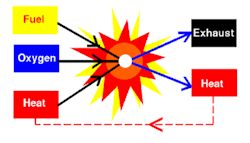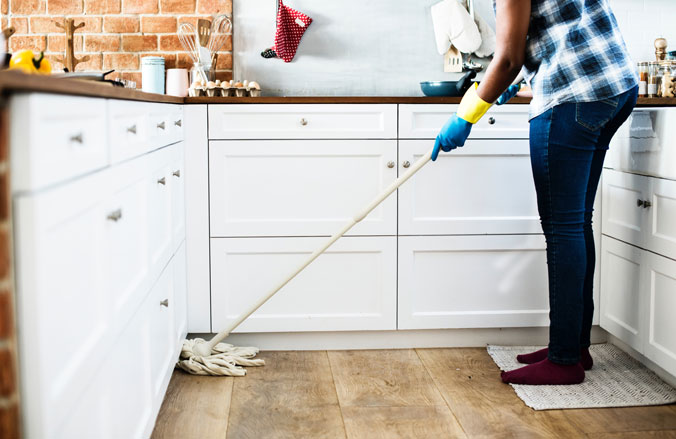Mold in My Home: What Do I Do?
About Mold: What is it?
Molds are simple, microscopic organisms, found virtually everywhere, indoors and outdoors. Molds can be found on plants, foods, dry leaves, and other organic material. Molds are needed for breaking down dead material. Mold spores are very tiny and lightweight, and this allows them to travel through the air. Mold growths can often be seen in the form of discoloration, ranging from white, to orange, and from green to brown and blank. When molds are present in large quantities, they can cause allergic symptoms similar to those caused by plant pollen.
Should I be concerned about mold in my home?
Yes, if the contamination is extensive. When airborne mold spores are present in large numbers, they can cause allergic reactions, asthma episodes, infections, and other respiratory problems for people. Exposure to high spore levels can cause the development of an allergy to the mold. Mold can also cause structural damage to your home. Similarly, when wood goes through a period of wetting, then drying, it can eventually warp and cause walls to crack or become structurally weak.
What does mold need to grow?
- Food sources (i.e leaves, wood, dirt, or paper)
- A source of moisture
- A place to grow
Can mold become a problem in my home?
Yes, if there is moisture available to allow mold to thrive and multiply. The following are sources of indoor moisture that may cause problems:
- flooding
- backed-up sewers
- humidifiers
- mud or ice dams
- damp basement or crawl spaces
- constant plumbing leaks
- houseplants — watering can generate large amounts of moisture
- steam from cooling
- shower/bath steams and leaks
- wet clothes on indoor drying lines
- clothes dryers vented indoors
- combustion applications (stoves) not exhausted to the outdoors.
CAUTION
If you see moisture condensation on the windows or walls, it is also possible that you have a combustion problem in your home. It is important to have sufficient fresh air available for fuel burning appliances, such as a furnace, water heater, stove/range, clothes dryer, as well as a firee in place.
 A shortage of air for those appliances can result in back drafting of dangerous gasses such a carbon monoxide into your home. To prevent back drafting of air, you need either open vents or a ventilation system that brings fresh air into the home to replace the air that is exhausted out. Have your local utility company or a professional heating contractor inspect your fuel-burning appliances annually.
A shortage of air for those appliances can result in back drafting of dangerous gasses such a carbon monoxide into your home. To prevent back drafting of air, you need either open vents or a ventilation system that brings fresh air into the home to replace the air that is exhausted out. Have your local utility company or a professional heating contractor inspect your fuel-burning appliances annually.
Health Effects
How am I exposed to indoor molds?
Mold is found everywhere, indoors and outdoors. It is common to find mold spores in the air of homes and growing on damp surfaces. Much of the mold found indoors comes form outdoor sources. Therefore, everyone is exposed to some mold on a daily basis without evident harm. Mold spires primarily cause health problems when the enter the air and are inhaled in large numbers. People can also be exposed to mold through skin contact and eating.
How much mold can make me sick?
It depends. For some people, a relatively small number of mold spores can cause health problems. For other people, it may take more. The basic rule is, if you can see or smell it, take steps to eliminate the excess moisture, and to cleanup and remove the mold.
Who is at greater risk when exposed to mold?
Exposure to mold is not healthy for anyone inside buildings. It is important to quickly identify and correct any moisture sources before health problems develop. The following individuals appear to be at high risk for adverse health effects of molds.
- Children and infants
- The elderly
- immune compromised patients (patients with HIV, AIDS, cancer patients undergoing chemotherapy, liver disease, etc)
- Pregnant women
- Individuals with respiratory conditions, such as allergies, multiple, chemical sensitivity, and asthma.
People with these special concerns should consult a physician if they are having health problems.
What symptoms are common?
Allergic reactions may be the most common health problem of mold exposure. Typical symptoms reported (alone or in a combination) include:
- respiratory problems, such as wheezing, and difficulty breathing
- nasal and sinus congestion
- eye-burning, watery, reddened, blurry vision, light sensitivity
- dry, hacking coughing
- sore throat
- nose and throat irritation
- shortness of breath
- skin irritation
- central nervous system problems (constant headaches, memory problems, and mood changes)
- aches and pains
- possible fever
Are some molds more hazardous than others?
Allergic persons vary in their sensitives to mold, both as to amount and type needed to cause reactions. In addition, certain types of molds can produce toxins, called mycotoxins, that the mold uses to inhibit or prevent the growth of other organisms. Mycotoxins are found in both living and dead mold sores. Materials permeated with mold need to be removed even after they are disinfected with cleaning solutions. Allergic and toxic effects can remain in dead spores. Exposure to mycotoxins may present a greater hazard than that of allergenic or irritative molds. Mycotoxins have been found in homes, agricultural settings, food, and office buildings.
Detection of Mold
How can I tell if I have mold in my house?
If you can see the mold, or if there is a earthy or musty odor, you can assume you have a problem. Allergic Individuals may experience the symptoms listed above. Look for previous water damage. Visible mold growth found underneath materials where water has damaged surfaces or behind walls. Look for discoloration and leaching from plaster.
Should I test my home for mold?
Reliable sampling for mold can be expensive, and requires equipment not available to the general public. Residents of individual private homes must pay a contractor to carry out such sampling, as it usually isn’t done by public health agencies. Mold cleanup is usually considered one of the housekeeping tasks of the private citizen, along with roof and plumbing repairs, sweeping and house cleaning.
Another problem is that there are few available standards for judging what is acceptable quantities of mold. In all locations, there is some outdoors levels of molds. If sampling is carried out, an outdoor air sample needs to be taken to provide a baseline measurement. Since the susceptibility of individuals varies so greatly, sampling is at best a general guide.
The simplest approach is: if you can see or smell mold, you have a problem. Once you know the problem exists, follow the procedure given next.
Unless the source of moisture is removed and the contaminated area is cleaned and infected, mold growth is likely to reoccur.

General Cleanup Procedures
- Identify and correct the moisture source
- Clean, disinfect, and dry the moldy area
- Bag and dispose any material that has moldy residues, such as rags, paper, leaves, or debris
What can I save? What should I toss?
Substances that are porous and can trap mold, such as paper, rags, wallboard, and rotten wood should be decontaminated and thrown out. Harder materials such as glass, plastic, or metal can be kept after they are cleaned and disinfected. Ultimately, it is critical to remove the source of moisture first, before beginning remedial action, since mold growth will return shortly if an effected area becomes wet again.
Removal of Moldy Materials
After fixing the moisture source and removing excess moisture, the cleanup can begin.
- If flooded, remove all sheet rock at least twelve inches above the high water mark. Visually inspect the wall interior and remove any other intrusive molds (this step may have to be carried out by a licensed contractor).
Caution: Spores are easily released when moldy material is dried out.
Soap Cleanup
Before disinfecting contaminated areas, clean the areas to remove as much of the mold (and food it is growing on (as possible).
- Wear gloves during this cleanup
- Use a non-ammonia soap or detergent, or a commercial in hot water, and scrub the entire affected by mold.
- Use a stiff brush or cleaning pad on block walls or uneven surfaces
- Rinse clean with water. A wet/dry vacuum is handy for this.
Disinfect Surfaces
- Wear gloves when using disinfectants
- After thorough cleaning and rinsing, disinfect the area wit ha solution of 10% household bleach (e.g 1 1/2 cup bleach per gallon of water). Using straight bleach from the bottle will NOT be more effective.
- NEVER mix bleach with ammonia (the fumes are toxic!)
- For spraying exterior large areas, a garden nose and nozzle can be used
- When disinfecting a large structure, make sure the entire surface is wet (floors, joists, and posts)
- Avoid excessive amounts of runoff or standing bleach
- Let disinfecting areas dry naturally overnight — this extended time is important to kill all the mold
CAUTION: Bleach fumes can irritate the eyes, nose, and throat. In addition it can damage clothing and shoes. Make sure the working area is ventilated well.
Can Cleaning up mold be hazardous to my health?
Yes. Exposure to mold can occur during the cleaning stage. Mold counts are typically 10 to 1000 times higher than background levels during the cleanup of mold damaged materials. Take steps to protect your health during cleanup:
- When handling or cleaning moldy materials, consider using a mask or respirator to protect you from breathing airborne spores. Respirators can be purchased from hardware stores; select one for particle removal (sometimes referred to as a N95 or TC-21C particulate respirator). Respirators are not as effective removing bleach fumes, so minimize your exposure when using bleach or other disinfectants.
- Wear protective clothing that is easily cleaned or discareded
- Use rubber gloves
- Try cleaning a small patch test of mold first. If you feel that this adversely affected your health, you should consider paying a licensed contractor or professional to carry out the work.
- Ask family members or bystanders to leave the area while you are cleaning
- Work over short time spans and rest in a fresh air location
- Air your house out afterwards
How can further damage to my home be prevented?
- Check regularly for the following:
- moisture condensation on windows
- cracking of plasterboard
- drywall tape loosening
- wood warping
- musty odor
Can ozone air cleaners help remove indoor mold, or reduce odor or pollution levels?
Some air cleaners are designed to produce ozone. Ozone is a strong oxidizing agent used as a disinfectant in water and sometimes to produce odors. However, ozone is known as a lung irritant. Symptoms associated with exposure include: cough, chest pain, eye/throat/nose irritation. Ozone generators have been shown to generate indoor levels above the same safe limit. Furthermore, it has been demonstrated that ozone is not effective in controlling molds and fungi, even at high concentrations far above safe health levels. Also ozone may damage materials in the home.
